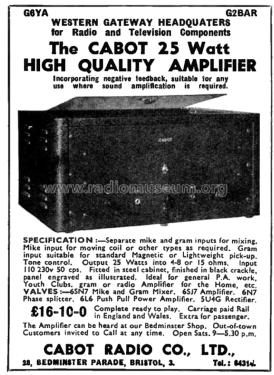Cabot 25-Watt High Quality Amplifier
Radford Electronics Ltd.; Bristol
- Country
- Great Britain (UK)
- Manufacturer / Brand
- Radford Electronics Ltd.; Bristol
- Year
- 1949 ?
- Category
- Audio Amplifier or -mixer
- Radiomuseum.org ID
- 360433
- Number of Tubes
- 7
- Main principle
- Audio-Amplification
- Wave bands
- - without
- Power type and voltage
- Alternating Current supply (AC) / 50 Hz, 110 - 230 Volt
- Loudspeaker
- - This model requires external speaker(s).
- Power out
- 25 W (undistorted)
- Material
- Metal case
- from Radiomuseum.org
- Model: Cabot 25-Watt High Quality Amplifier - Radford Electronics Ltd.;
- Shape
- Tablemodel, Box - most often with Lid (NOT slant panel).
- Notes
-
The Cabot 25-Watt High-Quality Amplifier, advertised by Cabot Radio Co. Ltd in 1949, was a versatile audio amplifier designed for various applications requiring sound amplification. This amplifier bears a striking resemblance to the Arthur H. Radford "Amplifier, Modified, Ex US Military," which Radford advertised in December 1948 which was a modifying surplus US military 25W TG10 Keyer amplifier.
Technical specifications and features of the Cabot amplifier:
Power and Output
- Output power: 25 Watts
- Output impedance: 4-8 or 15 ohms
- Power supply: 110-230V, 50 Hz
Input and Controls
- Separate microphone and gramophone inputs for mixing
- Microphone input compatible with moving coil or other types as required
- Gramophone input suitable for standard magnetic or lightweight pick-ups
- Tone control included
Valve Configuration
- 6SN7: Microphone and gramophone mixer
- 6SJ7: Amplifier stage
- 6N7: Phase splitter
- 6L6: Push-pull power amplifier (likely a pair)
- 5U4G: Rectifier
Design Features
- Incorporated negative feedback for improved performance
- Housed in a steel cabinet with a black crackle finish
- Engraved front panel
Applications
- The amplifier was marketed as suitable for:
- General public address (P.A.) work
- Youth clubs
- Home use as a gramophone or radio amplifier
Like the earlier amplifier, the Cabot amplifier's design, incorporating a push-pull output stage and negative feedback, was typical of high-quality amplifiers of the era. The use of a 6SN7 dual-triode for mixing, followed by a 6SJ7 pentode amplifier stage, provided good gain and flexibility for various input sources. The 6N7 phase splitter fed the push-pull 6L6 output stage, which was capable of delivering the specified 25 watts of power. The 5U4G rectifier was a common choice for providing high-voltage DC to the amplifier stages.
The similarities between the Cabot and the Radford "Modified, Ex US Military" amplifier suggest a possible rebadge of the earlier model with a 110 – 230 V AC power supply transformer.
Priced a £16/10- complete.
Note: the 1948 original version was £8/13/6 including the stepdown to 110 V mains transformer.
- Price in first year of sale
- 16.50 GB £
- Mentioned in
- Wireless World (The), London (WW, 79) (Jul 1949, Page Ad 56)
- Author
- Model page created by Gary Cowans. See "Data change" for further contributors.
- Other Models
-
Here you find 32 models, 25 with images and 10 with schematics for wireless sets etc. In French: TSF for Télégraphie sans fil.
All listed radios etc. from Radford Electronics Ltd.; Bristol
